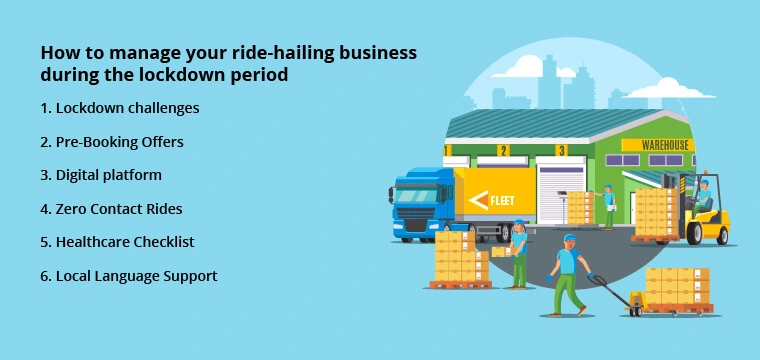How to manage your ride-hailing business during the lockdown period

Leading companies implement innovative strategies to overcome the crisis and manage their ride-hailing business. However, they can handle the business situation better during these uncertain times. They arrange the transportation facility for healthcare professionals, senior citizens, medical emergencies, and other underprivileged individuals by partnering with administration departments during the phase of the coronavirus pandemic. The restrictions on mobility have eased with a few guidelines recently. The driver should take a selfie with the face mask and update the same to initiate new rides.
Lockdown challenges:
Taxi service companies are given priority for medical emergencies. Many people are unable to get essential products for their children and parents. Consequently, the operators of the taxi dispatch system launch exclusive services for delivering essential goods to needy people in some countries. They provide their dispatch service at a cheaper price, and this initiative helps the service provider to get ride requests and support the riders for their survival. In addition, few companies facilitate consumers to hire riders to run their personal vehicles.
Pre-Booking Offers:
Customers can schedule their rides in advance. Pre-booking is a core feature of the taxi dispatch system, and it helps to find out the nearest available taxi. Ride-hailing companies should announce an offer for pre-booking to get more advance bookings. The management of the taxi application has an eye on these advance bookings whether the rider is reaching the passenger on-time or not. They are able to know the total number of advance bookings and accordingly manage the cabs and riders.
Digital platform:
Taxi owners should make a plan to revamp their system in all possible ways. Digitizing the ride-hailing business is one of the best methods to upgrade their system to draw new customers. They should allow the customers for book rides within a few clicks. Despite the current restrictions, they can receive bookings and rides using this digital platform. The digital solution helps to automate the riding operations and dispatch the passengers to the requested place at the earliest.
Zero Contact Rides:
Ride-hailing companies have set up a sanitation hub in pick-up zones, and the cabs are sanitized before each ride. When a person with COVID-19 coughs or exhales, coronavirus spreads from one person to the other. The virus transmission has happened through droplets from the mouth or nose. Taxi owners should ensure zero-contact between passengers, and their executives. Hence, they should maintain social distance while traveling. In addition, drivers should request the customers for digital payments for their service and ensure customers at a safe distance.
Healthcare Checklist:
Face mask is a primary precaution to keep away from the infection. Taxi owners should insist on the drivers to upload a selfie in the driver application before accepting rides. They should include a health checklist in the driver application to confirm the drivers are in good health and maintain the hygiene in the taxi. When the rider or the passenger has symptoms of coronavirus disease, their mobile application allows the customers, and drivers to cancel the rides without bearing a penalty.
Local Language Support:
The companies should give the comfort of accessing the ride-hailing platform by using their preferred language. It is possible when the taxi dispatch software is integrated with multiple languages. Taxi owners can expand their service boundaries easily and help people during unpredictable times. The admin panel should send the relevant push notifications to customers in their preferred language.
Thus, the coronavirus outbreak slows down economic growth and people remain locked down in their homes. The impact of this pandemic is stronger for ride-hailing business than other businesses. It is time to find new ways to generate more revenue and make a successful comeback once the market is active again. Therefore, Looking at opportunities in challenging times is better than seeing challenges in the opportunities.
Latest Posts
- Transforming E-commerce: How Seamless Order Management Enhances Customer Experience
- Fast Track Optimization: The Art and Science of the Most Efficient Route Planner
- Mastering Efficiency: The Role of Real-time Tracking Solutions in Restaurant Business
- The Future of Delivery: How Streamlined Logistics Can Transform Your Operations
- Real-time Handling: Key to Solving Dispatch Delivery Problems
- The Powerful Impact of Grocery Delivery Management System on Retail Business
- Benefits of an Automated Dispatch Software for your Business
- Six Essential Task-handling Features in Delivery Tracking System Software
- 8 Reasons to Implement Software-based Dispatch Management in this Era
- Reengineering Urban Mobility: Unveiling the Power of Dispatch Delivery Management System